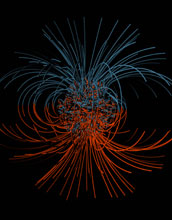Multimedia Gallery
Earth's Magnetic Field
Earth's Magnetic Field
A geodynamo simulation computed on Pittsburgh Supercomputer Center's LeMieux supercomputer shows inward-directed magnetic field lines (blue) and outwar-directed lines (red). The complicated field of the core becomes smoother at Earth's mantle. Gary Glatzmaier of the University of California, Santa Cruz and his colleague Paul Roberts of UCLA developed the first computational model of these geodynamic processes that evolves on its own self consistently. This model has successfully simulated many features of Earth's magnetic field, including magnetic-field reversal, a recognized phenomenon that has happened many times over Earth's history. In recent work with LeMieux, Glatzmaier and graduate student Darcy Ogden have investigated heat from radioactive decay in the inner core as a buoyancy source that may help to drive the geodynamo.
This research is supported by National Science Foundation grants EAR 99-02969 and EAR 02-21941. (Date of Image: Sept. 5, 2004)
Credit: Gary Glatzmaier, University of California, Santa Cruz; Paul H. Roberts, UCLA; Darcy E. Ogden, UC Santa Cruz
Images and other media in the National Science Foundation Multimedia Gallery are available for use in print and electronic material by NSF employees, members of the media, university staff, teachers and the general public. All media in the gallery are intended for personal, educational and nonprofit/non-commercial use only.
Images credited to the National Science Foundation, a federal agency, are in the public domain. The images were created by employees of the United States Government as part of their official duties or prepared by contractors as "works for hire" for NSF. You may freely use NSF-credited images and, at your discretion, credit NSF with a "Courtesy: National Science Foundation" notation.
Additional information about general usage can be found in Conditions.
Also Available:
Download the high-resolution TIF version of the image. (12.5 MB)
Use your mouse to right-click (Mac users may need to Ctrl-click) the link above and choose the option that will save the file or target to your computer.



